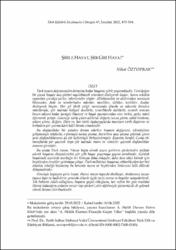| dc.contributor.author | Öztoprak, Nihat | |
| dc.date.accessioned | 2023-05-05T09:03:11Z | |
| dc.date.available | 2023-05-05T09:03:11Z | |
| dc.date.issued | 2022 | en_US |
| dc.identifier.citation | ÖZTOPRAK, Nihat. "Şiirle Hayat, Şiir Gibi Hayat". Türk Kültürü İncelemeleri Dergisi, 47 (2022): 475-504. | en_US |
| dc.identifier.uri | https://tkidergisi.com/tki-dergisi/siirle-hayat-siir-gibi-hayat | |
| dc.identifier.uri | https://hdl.handle.net/11352/4557 | |
| dc.description.abstract | Türk insanı doğumundan ölümüne kadar hayatını şiirle yaşamaktadır. Yeni doğan
bir çocuk hayata ana şiirleri sayılabilecek ninnileri dinleyerek başlar. Sonra sokakta
oynarken çocukça şiirler, tekerlemeler söyler. Ablalarından ve abilerinden manzum
bilmeceler, dede ve ninelerinden mâniler, mevlitler, ilahiler, tevhitler, dualar
dinleyerek büyür. Her yıl idrak ettiği ramazanda iftarda ve sahurda davulcu
mânileriyle, şiir tadında kafiyeli dualarla, teravihlerde ilahilerle, teravih sonrası
bazen sahura kadar karagöz Hacivat ve hayal oyunlarından nice türkü, şarkı, mâni
öğrenerek yetişir. Geleneğe sahip çıkan ailelerde doğum, hacca gitme, sakal bırakma,
askere gitme, düğün, ölüm vs. her türlü başlangıçlarda manzum tarih düşürme ve
levhalara şiir yazma âdeti hâlâ devam etmektedir.
Bu alışkanlıklar bir yandan devam ederken hayatın değişmesi, teknolojinin
gelişmesiyle telefonla, e-postayla mesaj yazma, duvarlara yazı yazma şeklinde giren
yeni alışkanlıklarımız da şiir kültürüyle birleştirilmiştir. Bayram, kandil, Cuma vb.
mesajlarda şiir yazmak veya şiir tadında mısra ve cümleler yazmak alışkanlıklar
arasına girmiştir.
Bu arada Türk insanı Yûnus başta olmak üzere şairlerin şiirlerinden istifade
ederek hayatını düzenlemekte şiir gibi hayat yaşamaya gayret etmektedir. Günlük
hayatında üzerinde durduğu her konuyu daha anlaşılır, daha ikna edici kılmak için
beyitlerden örnekler getirmeye çalışır. Türk milletinin hayatına rehberlik eden her biri
atasözü niteliği kazanmış bu berceste mısra ve beyitlerden binlercesi hâlâ dillerde
dolaşmaktadır.
Ninniyle başlayan şiirle hayat, ölünce mezar taşında ebedileşir. Atalarımız mezar
taşına âyet ve hadislerin yanında ölümle ilgili veciz mısra ve beyitler nakşederlerdi.
Tek bakinin Allah olduğunu, hayatın geçici olduğunu, her nefsin bir gün mutlaka
ölümü tadacağını anlatan mezar taşı şiirleri Latin alfabesiyle günümüzde de gelenek
olarak devam ettirilmektedir.Bu makalede beşikten mezara kadar Türk insanının geçirdiği şiirle ve şiirce hayat,
giriş bölümü ve onunla birlikte iki bölüm halinde ele alınarak ortaya konmaya
çalışılmıştır. Giriş bölümünde şiirin hususiyetleri ve insan - şiir ilişkisi, birinci
bölümde hayatın şiirli safhaları, ikinci bölümde ise berceste şiirlerin hayatta
kullanımı üzerinde durulmuştur. | en_US |
| dc.description.abstract | Turkish people live their lives with poetry from birth to death. A newborn child
begins his life by listening to lullabies, which can be considered as mother’s poems.
Then it continues with a nursery rhyme from childish poems on the street. They
grows up listening to manis from their older brothers/sisters, riddles in verse from
their elders, mawlids, hymns, tawhids and prayers. They continue their lives with
poetry in Ramadan, which they realize every year, with drummer's manis at iftaar
and sahoor, with rhyming prayers in the taste of poetry, with hymns in tarawih
prayers, with Karagöz Hacivat and shadow plays until sahoor after tarawih. The
custom of chronogram in verse and writing poems on plates still continues in all
kinds of beginnings such as birth, pilgrimage, beard growth, military service,
wedding, death etc.
While these habits continue on the one hand, our new habits in the form of writing
messages on the phone, e-mail and writing on the walls have been combined with
the culture of poetry with the change of life and the development of technology. It
has become a habit to write poetry in messages or to write verses and sentences with
the taste of poetry on Eid days, holy nights, Fridays, etc..
Meanwhile, Turkish people organize their lives by benefiting from the poems of
poets, especially Yunus, and try to live a life like poetry. They try to bring examples
from couplets in order to make every subject they focus on in their daily lives more
understandable and more convincing. Thousands of verses and couplets are still
circulating each of which has become a proverb, which guides the life of the Turkish
nation.
Life begins with poetry, lullaby. In the end, it becomes eternal on the tombstone.
Our ancestors used to engrave concise verses and couplets about death as well as
verses and hadiths on their gravestones. The tombstone poems that explain that
Allah is the only remnant, that life is temporary, that every soul will surely taste
death one day... are still a tradition today, in the Latin alphabet.
In this article, the poetry and poetic life of a Turkish person from cradle to grave is
tried to be revealed in the introduction and the other two parts. In the introduction,
the characteristics of the poem and the relationship between human and poetry are
mentioned. In the first chapter, the poetic phases of life and in the second chapter,
the use of berceste poems in life are emphasized. | en_US |
| dc.language.iso | tur | en_US |
| dc.publisher | KOCAV Kültür Ocağı Vakfı | en_US |
| dc.relation.isversionof | 10.24058/tki.2022.454 | en_US |
| dc.rights | info:eu-repo/semantics/openAccess | en_US |
| dc.subject | Şiir | en_US |
| dc.subject | Şiirce Hayat | en_US |
| dc.subject | İnsan ve Şiir | en_US |
| dc.subject | Poetry | en_US |
| dc.subject | Poetic Life | en_US |
| dc.subject | Life Like Poetry | en_US |
| dc.subject | Human and Poetry | en_US |
| dc.title | Şiirle Hayat, Şiir Gibi Hayat | en_US |
| dc.title.alternative | Life With Poetry, Life Like Poetry | en_US |
| dc.type | article | en_US |
| dc.relation.journal | Türk Kültürü İncelemeleri Dergisi | en_US |
| dc.contributor.department | FSM Vakıf Üniversitesi, Edebiyat Fakültesi, Türk Dili ve Edebiyatı Bölümü | en_US |
| dc.contributor.authorID | https://orcid.org/0000-0002-7400-0180 | en_US |
| dc.identifier.volume | 47 | en_US |
| dc.identifier.startpage | 475 | en_US |
| dc.identifier.endpage | 504 | en_US |
| dc.relation.publicationcategory | Makale - Uluslararası Hakemli Dergi - Kurum Öğretim Elemanı | en_US |
| dc.contributor.institutionauthor | Öztoprak, Nihat | |



















